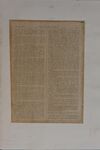< The Progress of Psychology (continued from page 10-116) >
And the forms so moulded are definite forms. They are not merely sportive shapes infinitely varied; they are beings—individuals—conscious selves—having sensations and existing for definite ends.
They rise, as it were, out of the ocean of protoplasm, take shapes, live lives, play a part in the scheme of creation, and, having played their part, the protoplasmic structures are dissolved and fall back again into that ocean of protoplasm whence they had emerged!
What, then, is the something that takes these shapes, and thus becomes perceptible, and plays a part in this molecular portion of creation?
I repeat this is what psychology calls “Soul” or “Spirit,” but whose existence, hitherto denied, and derided by physical science, that very science, by the discovery of protoplasm, proved to be a fact, and, more than this, has publicly acknowledged it.
And what does it prove?
This. There is something invisible, impalpable, imperceptible by our imperfect senses that broods upon, or more probably permeates, that protoplasm, giving to it shape and character, sensation, consciousness, individuality, and intelligence. Itself imperceptible by the cell-formed senses, that something becomes perceptible when it clothes itself with protoplasmic matter as with a garment. Of its own power, or by any conceivable indwelling force, protoplasm could not mould itself even into the structure of a monad, much less into the curiously complicated mechanism of man, with his self-consciousness and his intelligence. Is it not more reasonable and probable that the forms so emerging from the protoplasmic jelly are not the automatic products of that jelly, but that the independent existences borrow the protoplasmic cells, with their inherent life-force, for the performance of their work in a world constructed of molecules—protoplasm itself being a special molecular combination of atoms the function of which is —Life.
Professor Allman distinctly recognises this conclusion from the facts, not indeed as an established truth, but as the probable presumption from those facts. “Here,” he says, “we stand upon the boundary between life in its proper conception as a group of phenomena having irritability as their common bond, and that other and higher group of phenomena which we designate as consciousness or thought, and which, however intimately connected with those of life, are yet essentially distinet from them.”
Verily this is a grand truth to be proclaimed from the platform of the British Association. Remember that it is an eloquent and emphatic repudiation of the materialism that has hitherto been taught from that platform. It is to us a great triumph, for it is a distinct acceptance of the principle for which psychology has so long fought, and upon which its claim to be a science—namely, the existence of some entity other than the protoplasmic structure; an entity existing under other conditions, and doubtless subject to other laws of being than is the molecular mechanism whose formation, growth, being, and dissolution are presented to our material senses.
This entity is what, for lack of a better name, we call soul or spirit. The purpose of our science is the investigation of the entity as recognised by Professor Allman as being “exhibited in other and a higher group of phenomena” than the phenomena of life.
But, having thus practically accepted the basis of psychology, we do emphatically protest against the Professor’s conclusion, that at this point there is a barrier impassable by human intelligence. He asserts that, although something other than protoplasm exists, we can know nothing beyond that protoplasm. “Have we,” he says, “made in all this one step further towards an explanation of the phenomena of consciousness, or the discovery of its source? Assuredly not. The power of conceiving a substance differing from that of matter is still beyond the limits of human intelligence.” “But,” he adds, “we are not on that account forced to the conclusion that there is nothing; in the universe but matter and force.”
Psychology joins issue with him as to this. We admit the existence of other combinations of atoms than that which makes molecules, which is but one of the infinite combinations of atoms our senses are constructed to perceive. But we deny that such an entity is either absolutely inconceivable, or that there is any difficulty in the conception of it. The question is not, can we conceive this, but do such nonmolecular forms exist as a fact in nature, and is it practicable for science to learn something of them?
Psychology asserts that not only can it conceive of such non-protoplasmic entities, but that it is within its capacity not merely to prove their existence, but to discover much in relation to their nature, powers, and functions.
And how does psychology propose to do this? By noting the action of that imperceptible something upon the perceptible protoplasmic structure and the substances that are perceptible to the senses because they are molecular. We claim to have accomplished already not a little in this direction, and we hope to discover very much more hereafter.
Hitherto we have been met by denial on the part of physicists of the existence of anything but the protoplasmic material of life. “Your science,” they have said, “is no science, for that which it professes to investigate is non-existing: it cannot be, and therefore it is not.”
But now their president asserts its existence. But he adds that it is inconceivable, and therefore unknowable.
Psychology replies that it can be conceived without difficulty, and investigated by the same process as the physical sciences are explored, by observation of phenomena and gathering together of facts for its foundation.
But half the controversy is closed by the President’s address; and this is the event in the review of the past year which psychology may fairly claim for itself as a great victory.
Now while this conversion of physicists to the fact that there is something other than protoplasm that moulds protoplasm to shape and intelligence has been <... continues on page 10-118 >

